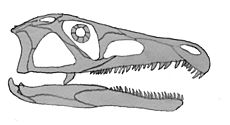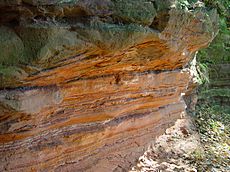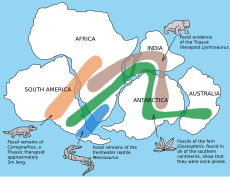Lower Triassic facts for kids

The Lower Triassic is the first of three epochs of the Triassic period. It lasted from about 252.2 million years ago (mya) to ~247.2 mya. The Lower Triassic is the oldest epoch of the Mesozoic era. These rocks were laid down just after the great Permian–Triassic extinction event.
The Lower Triassic was called the Scythian stage, which can be found in older literature. In Europe, most of the Lower Triassic is composed of sandstone. It is a lithostratigraphic unit of continental red beds. They were formed on land under desert conditions.
Fauna
The massive extinctions that ended the Paleozoic era caused extreme hardship for the surviving species. Many types of corals, brachiopods, molluscs, echinoderms, and other invertebrates had completely disappeared. The most common hard-shelled marine invertebrates were bivalves, gastropods, ammonites, echinoids, and a few articulate brachiopods. The most common land animal was the herbivorous synapsid Lystrosaurus.
The earliest Triassic faunas lacked biodiversity and were like that throughout the epoch. Recovery on land took 30 million years.
The first ichthyosaurs evolved in this epoch.
The climate during the Lower Triassic (especially in the interior of the supercontinent Pangaea) was generally dry. Deserts were widespread. The poles had a temperate climate. The relatively hot climate of the epoch may have been caused by widespread volcanic eruptions.
Images for kids
-
The Putorana Plateau is composed of basalt rocks of the Siberian Traps.
-
Early Triassic and Anisian marine predators: 1. Wantzosaurus, 2. Fadenia, 3. Saurichthys, 4. Rebellatrix, 5. Hovasaurus, 6. Birgeria, 7. Aphaneramma, 8. Bobasatrania, 9. Hybodontiformes, 10. Mylacanthus, 11. Tanystropheus, 12. Corosaurus, 13. Ticinepomis, 14. Mixosaurus, 15. Cymbospondylidae, 16. Neoselachii, 17. Omphalosaurus skeleton, 18. Placodus
-
Early Triassic brittle stars (echinoderms)
-
Fossils of the bivalve Claraia clarai
-
Early Triassic ammonoid Hedenstroemia
-
Fossil of the Early Triassic neopterygian Candelarialepis argentus
See also
 In Spanish: Triásico Inferior para niños
In Spanish: Triásico Inferior para niños










